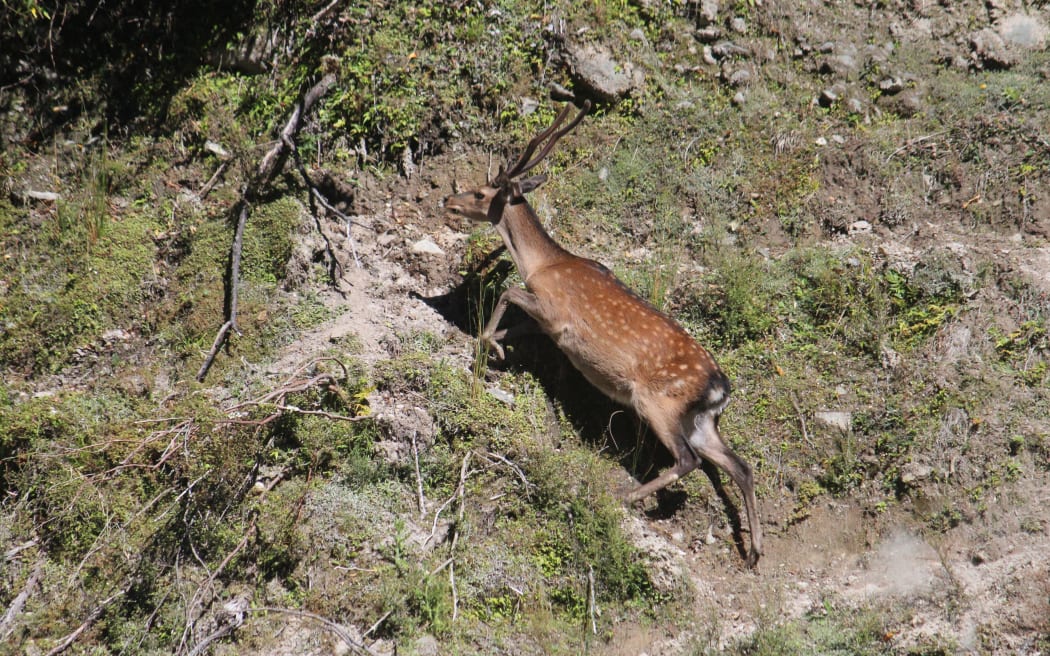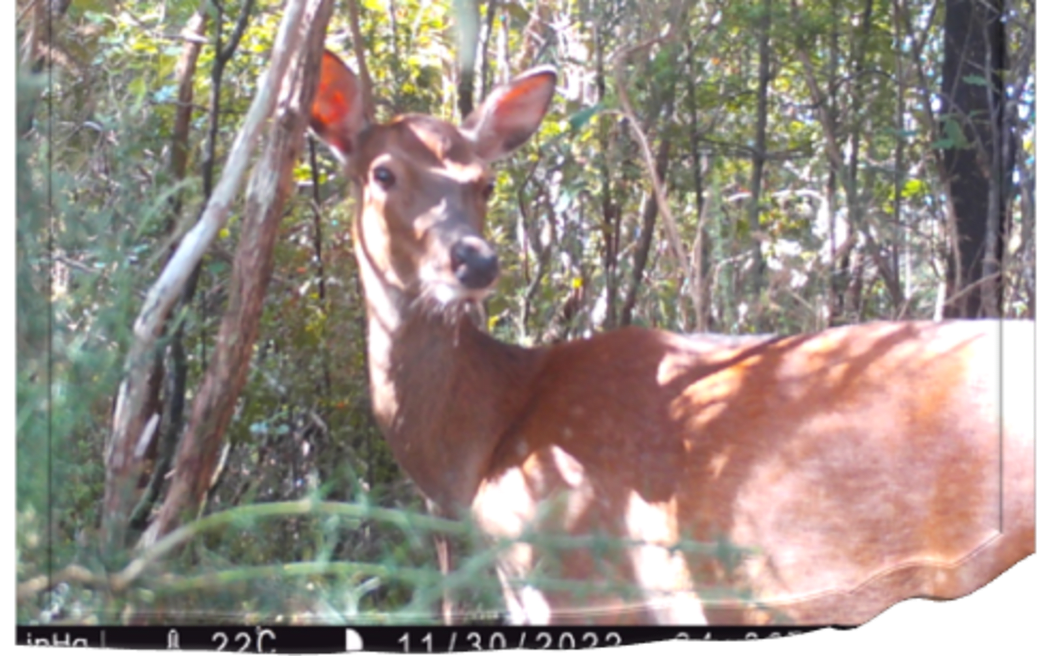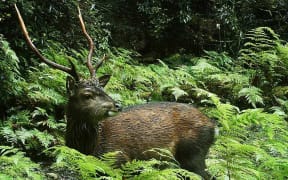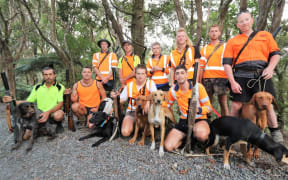
Originally from Japan, sika are smaller and more wily than other species of deer found in New Zealand. Photo: DOC / Steve Pilkington
An ambitious plan to make Northland the first region in New Zealand to eradicate wild deer is underway near the Bay of Islands.
The Wild Deer Free Te Tai Tokerau programme started in earnest on Monday night with a small team of hunters heading into Russell State Forest, equipped with thermal drones to help them home in on their targets after sunset.
The 10-year programme is being trialled in Russell Forest because of its ecological value and because it has the only known population of sika deer in Northland.
Nicky Fitzgibbon, a biosecurity manager at the Northland Regional Council, said unlike many other parts of New Zealand, the acclimatisation societies of the 19th century never released deer in Northland.
Instead, they arrived in the 1980s and 1990s as a result of deer farm escapes and illegal releases.
Fitzgibbon said there were now up to 14 small, isolated populations of deer, from Kaiwaka, near the Auckland border, to the Kai Iwi Lakes north of Dargaville and the bush behind Kaitāia airport.
Fitzgibbon said deer could pose a serious threat to Northland if left to breed.
"They feed on our ngahere, our forest, and they change the composition of the forests, which are already under lots of pressure from possums and pigs and other things, so this is just another threat," she said.
"And it's not just our forests, deer also potentially threaten our agriculture, forestry and even tourism, because people like to visit the North for the beautiful forests."
The Russell State Forest pilot had been more than four years in the making with the hapū Te Kapotai, Ngāti Kuta and Patukeha, Ngatiwai iwi and hau kainga from Ngaiotonga.
"Russell's a real treasure, it's got lots of precious and unique ecosystems. This work is working towards preserving the natural and cultural heritage for future generations and supports the hapū in their aspirations for their 20-year forest health plan."
Fitzgibbon said the hunters had got off to a good start with three hinds shot in the first nights and a local land holder shooting a young male.
They would work three weeks on, one week off, depending on the weather.
Poison was not being used.
She said now, while deer numbers were still low, was the time to attempt eradication.
"You just look across the country where wild deer are in greater numbers, and their forests have been really decimated. We all know how expensive getting rid of pests can be, so it's really important we invest and commit to getting rid of them now while we still can."

Trail cam image of a sika hind at Ngaiotonga Reserve, south of Russell. Photo: DOC
Fitzgibbon said if the project succeeded, Northland would be the biggest deer-free area on the New Zealand mainland.
"We don't just dream big, we do big here in the North."
Wild Deer Free Te Tai Tokerau is a partnership between the regional council, the Department of Conservation, hapū, iwi and the deer farming industry.
DOC senior wild animal advisor Dave Carlton said deer had no natural predators in New Zealand, so their population could grow rapidly, damaging native plants and habitats.
Northland was the ideal place to aim for deer-free status because the region was bounded by the sea on two sides and Auckland on the other.
DOC also worked closely with Auckland Council to maintain a buffer on the boundary with Northland, to ensure deer from Auckland could not migrate north.
Carlton said wild deer fed on forest plants, trees and seedlings, altered the composition of forests, and took food and shelter away from native animals.
In some cases they could also hinder forest regeneration and reduce environmental resilience to the effects of climate change.
"So it's important we stop that happening from the get-go, if we can."
It was sometimes argued that deer simply took the place of moa in the New Zealand forest ecosystem, but Carlton said moa had a "completely different" way of feeding.
"They really can't be compared to the likes of an ungulate animal. Deer will eat anything in reach they consider palatable. They'll eat the plant to the ground and any seedling that tries to come up through the ground will get cut off at the base, stopping regeneration of any palatable species."
Moa, on the other hand, fed by "plucking bits off the trees, not wholesale consumption of the entire tree".
Carlton said the types of deer found in Northland were sika, red and fallow, but it was possible some reds could be wapiti hybrids.
Russell Forest had Northland's only known population of sika, illegally released there 35 years ago.
Their normal feral range was 400km away in the Kaimanawa and Kaweka mountains of the central North Island.

You're on candid camera! A sika hind is captured by a trail cam in Russell State Forest. Photo: DOC
Sika were the smallest species of deer in New Zealand but they were a big concern.
"They're quite wily compared to other species of deer, so they are very difficult to hunt and control, so once they get established it's hard to get rid of them again. They also eat a wider range of species than red or fallow deer, and out-compete other species as well. Over time they can push red deer out of an area."
Carlton acknowledged deer hunting could be a valuable source of food and recreation.
"That's a totally valid argument across a lot of New Zealand, where deer have been established for a long time and people do rely on them as a food source and recreation in some circumstances. But that's not part of Northland's culture. Deer only starting appearing in Northland in the 1980s and since that time there's been a lot of effort to remove every population that has turned up."
If eradication succeeded in Northland it could be rolled out to other areas, such as the Coromandel Peninsula and parts of Auckland and Taranaki.
"In the rest of New Zealand, where deer have been established for a long time, this isn't really feasible. It quickly becomes completely unaffordable and you can't manage re-invasion from surrounding areas."
In those regions the plan was to work with local communities to manage populations and reduce the impact of deer on the environment, rather than trying to eradicate them.
Northland regional councillor Marty Robinson said Russell Forest was the largest inland forest and scrubland area of Northland's east coast.
It was an important example of a warm temperate rainforest and contained kauri, tawa, kotukutuku (tree fuchsia) and tōtara along with threatened birds such as the North Island brown kiwi.
Unlike most forests around the country, it had not been significantly altered by introduced mammalian browsers.
The regional council has allocated $5.9m for managing deer in Northland until 2031, with funding from central Government's 2022 Budget.
The Russell Forest sika project is expected to cost $1.5m.
* Call 0800 WILD DEER or go to https://www.nrc.govt.nz/wilddeer to report wild deer sightings in Northland.



